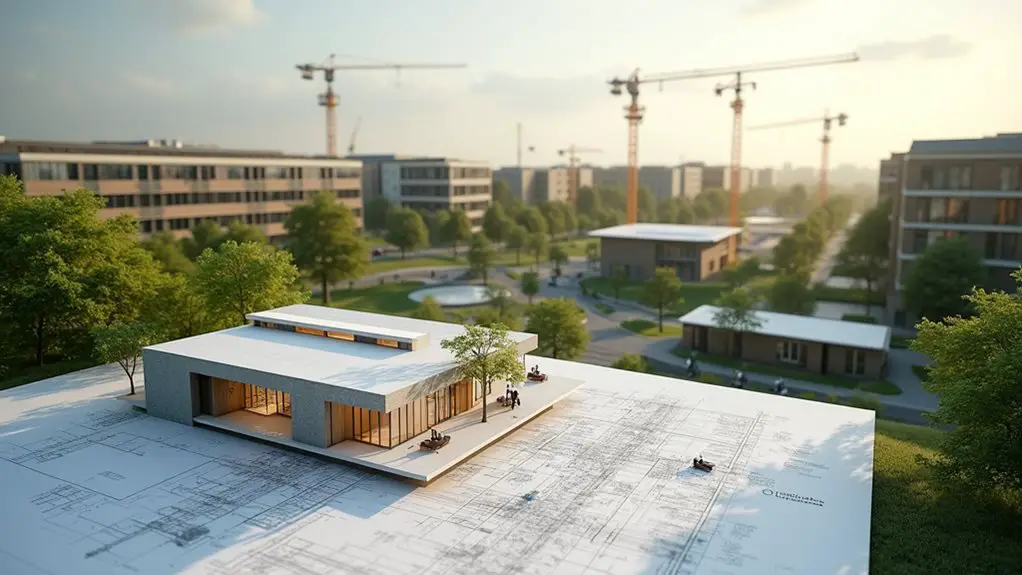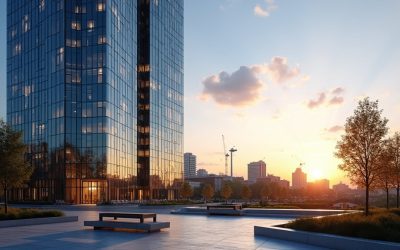The Crown Estate and Lendlease have partnered in a £24 billion joint venture to transform UK housing and innovation sectors. You’ll see approximately 26,000 new homes built across the country, with one-third designated as affordable housing. The initiative will create around 100,000 jobs and develop 10 million square feet of workspace and laboratories. Key locations include Euston Station and Smithfield Market in Birmingham. This strategic alliance addresses critical national priorities in housing and technological advancement.

The Crown Estate and Lendlease have formed a groundbreaking joint venture aimed at transforming the UK’s housing realm with a staggering £24 billion investment. This noteworthy partnership focuses on both housing and science innovation hubs throughout the United Kingdom, directly supporting the government’s Plan for Change.
You’ll see this partnership deliver approximately 26,000 new homes across various UK locations. About one-third of these homes will be designated as affordable housing, helping the government reach its ambitious target of building 1.5 million new homes by 2029.
The initiative will create around 100,000 new jobs across multiple sectors. These employment opportunities will emerge through both construction activities and the long-term operation of the developed facilities, boosting local economies throughout the nation.
Beyond housing, the partnership aims to revolutionize the UK’s science, technology, and innovation environments. The joint venture plans to develop approximately 10 million square feet of workspace and laboratories dedicated to growing sectors like life sciences and digital technologies.
You’ll notice these innovation hubs will provide specialized facilities for research and development activities. The partners will focus on major sites including the 60-acre Euston Station development with potential for 4.3 million square feet of commercial space and 2,000 homes. These spaces will foster collaboration between academic institutions, startups, and established companies, creating ecosystems for innovation and commercial growth.
The £24 billion investment represents one of the largest recent commitments to UK infrastructure and development. This financial backing guarantees the ambitious scope of the projects can be realized with appropriate resources and expertise.
The partnership aligns perfectly with the government’s upcoming modern Industrial Strategy. The venture includes other key locations such as Smithfield Market in Birmingham, which will become a vibrant hub for residential and commercial development. By investing in key growth areas and addressing housing shortages, the joint venture addresses multiple national priorities simultaneously.
The Crown Estate brings its noteworthy land portfolio to the partnership, while Lendlease contributes its development expertise. Together, they create a powerful alliance with the capabilities to deliver complex, large-scale projects that individual organizations might struggle to accomplish alone.
Through this partnership, you’ll see substantial positive impacts on both the housing sector and innovation-driven industries, creating lasting economic benefits across the United Kingdom.
Frequently Asked Questions
What Environmental Sustainability Standards Will the Developments Follow?
You’ll see developments following some of the world’s most stringent environmental standards, targeting at least 35% CO2 reductions beyond current building regulations.
That’s notably higher than the 19% reduction required by Code Level 4 standards.
These projects integrate sustainability holistically through design, construction, and operations phases.
They’ll incorporate low-carbon materials, renewable energy sources, and green infrastructure that supports biodiversity while aligning with the UK Government’s 2050 carbon neutrality goals.
How Will Local Communities Participate in the Planning Process?
You’ll have multiple opportunities to participate in the planning process.
Local community engagement will take place through public consultations, town hall meetings, and interactive planning workshops.
The Crown Estate and Lendlease will establish community advisory boards to gather input on housing needs, employment opportunities, and infrastructure requirements.
Digital platforms will allow you to provide feedback online, while dedicated community liaison officers will work directly with neighborhood groups to guarantee diverse voices are heard throughout development stages.
What Affordable Housing Percentages Will Be Included?
You’ll see approximately one-third of the planned 26,000 new homes designated as affordable housing, equating to roughly 8,500-8,700 affordable units.
This commitment aligns with the UK government’s housing policy and supports the national target of building 1.5 million new homes by 2029.
The exact breakdown of affordable housing types (social rent, shared ownership, etc.) hasn’t been publicly detailed yet, though the affordable provision remains a core element of the development pipeline.
How Might Brexit Impact the Long-Term Investment Strategy?
Brexit will influence your long-term investment strategy through several key factors. The pound’s devaluation makes UK properties more affordable for you as an international investor.
You’ll need to maneuver through new regulatory complexities while potentially benefiting from the market’s demonstrated resilience.
Consider diversifying across regions, as cities outside London show stronger growth post-Brexit.
You should also account for potential inflation and interest rate fluctuations in your planning, though Savills’ projection of 21.6% growth by 2028 suggests positive long-term potential.
What Technologies Will Be Incorporated Into These “Innovation Districts”?
You’ll find several advanced technologies incorporated into these innovation districts.
Smart building systems will use AI and sensors to optimize energy usage and comfort. IoT devices will manage resources efficiently across the development.
5G connectivity will guarantee high-speed internet throughout the area. Sustainable energy systems, including solar and wind power, will reduce environmental impact.
Smart grid systems will distribute energy intelligently, while data analytics platforms will improve operational efficiency across all systems.


